Australian Commercial Law: Ostensible Authority and Misleading Conduct
VerifiedAdded on 2023/03/23
|7
|1657
|75
Report
AI Summary
This report provides an analysis of key aspects of Australian Commercial Law. It begins by defining and explaining the concepts of ostensible authority and estoppel in the context of agency law, including the requirements for apparent authority and the application of estoppel. The report then explores Section 18 of the Australian Consumer Law, which prohibits misleading and deceptive conduct in business. It clarifies the elements of this section through case law, including the significance of misleading representations and the role of silence. The report also discusses relevant case law, such as Winter v Hockley Mint Limited and Devren Pty Ltd v Old Coach Developments Pty Ltd, to illustrate the practical application of these legal principles. Furthermore, it references cases like ACCC v Telstra Corporation Ltd, Johnson Tiles Pty Ltd v Esso Australia Ltd, and Demagogue Pty Ltd v Ramensky to elaborate on the interpretation and application of consumer law provisions. The report concludes by providing a comprehensive bibliography of sources used.
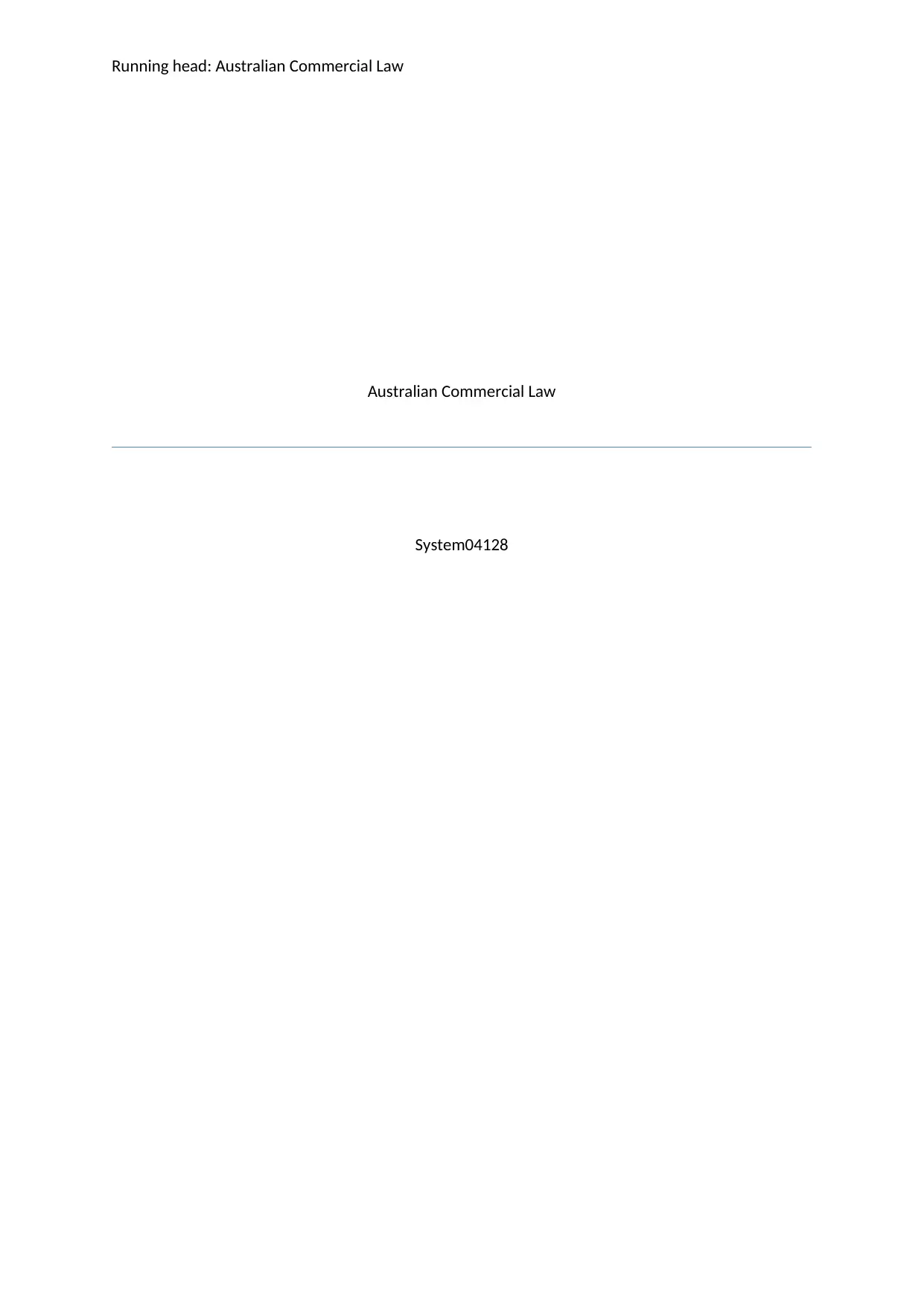
Running head: Australian Commercial Law
Australian Commercial Law
System04128
Australian Commercial Law
System04128
Paraphrase This Document
Need a fresh take? Get an instant paraphrase of this document with our AI Paraphraser
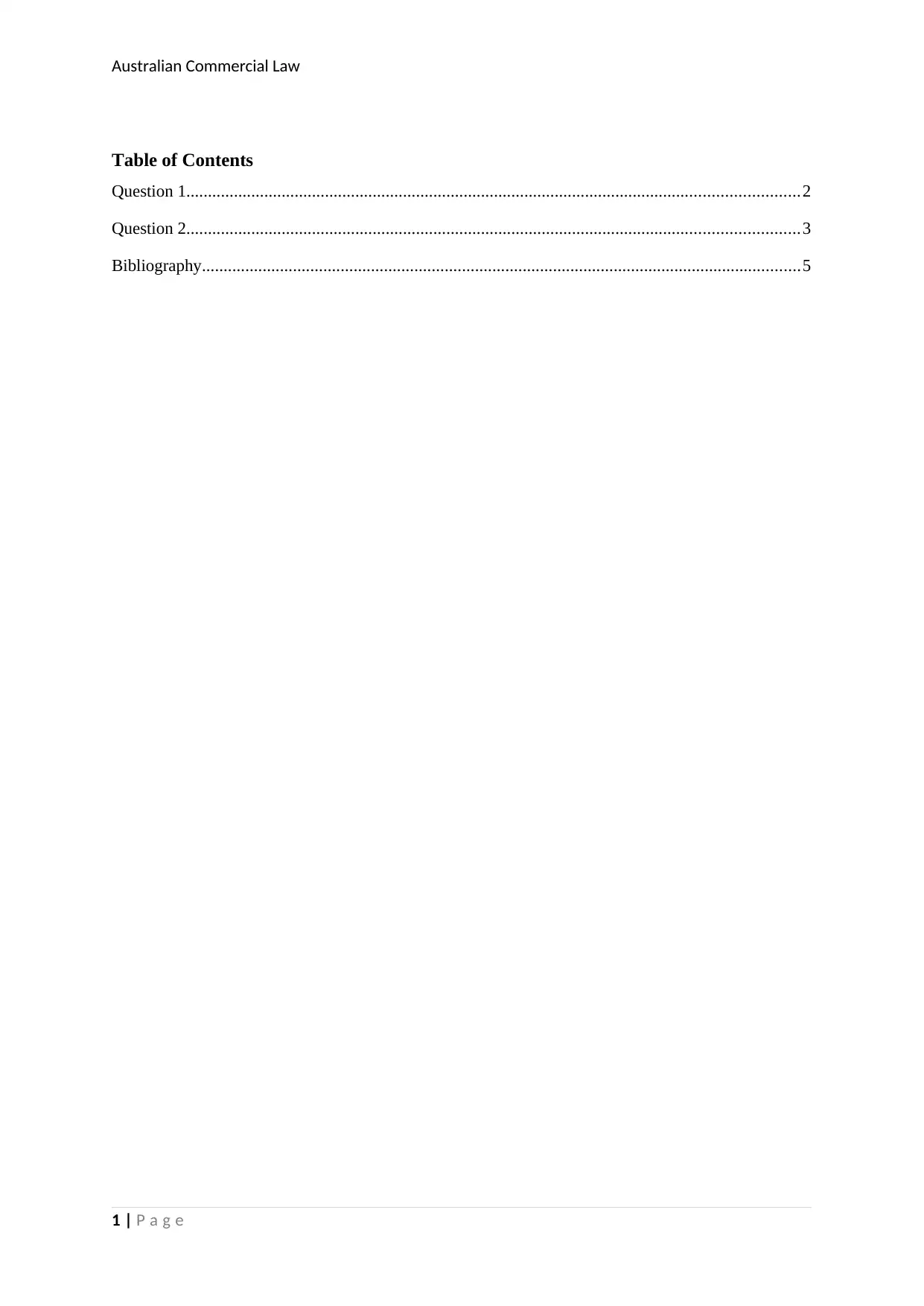
Australian Commercial Law
Table of Contents
Question 1.............................................................................................................................................2
Question 2.............................................................................................................................................3
Bibliography..........................................................................................................................................5
1 | P a g e
Table of Contents
Question 1.............................................................................................................................................2
Question 2.............................................................................................................................................3
Bibliography..........................................................................................................................................5
1 | P a g e
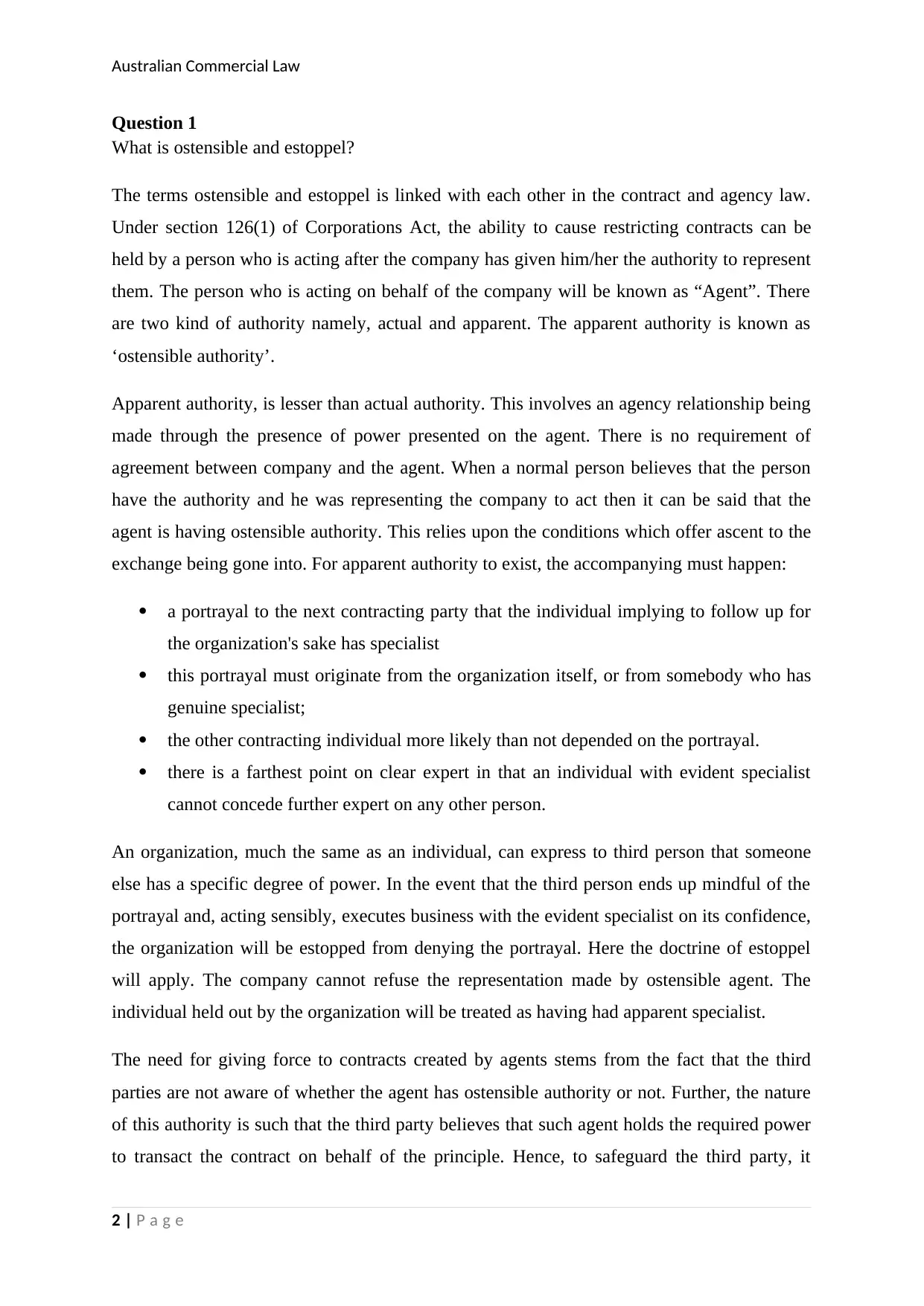
Australian Commercial Law
Question 1
What is ostensible and estoppel?
The terms ostensible and estoppel is linked with each other in the contract and agency law.
Under section 126(1) of Corporations Act, the ability to cause restricting contracts can be
held by a person who is acting after the company has given him/her the authority to represent
them. The person who is acting on behalf of the company will be known as “Agent”. There
are two kind of authority namely, actual and apparent. The apparent authority is known as
‘ostensible authority’.
Apparent authority, is lesser than actual authority. This involves an agency relationship being
made through the presence of power presented on the agent. There is no requirement of
agreement between company and the agent. When a normal person believes that the person
have the authority and he was representing the company to act then it can be said that the
agent is having ostensible authority. This relies upon the conditions which offer ascent to the
exchange being gone into. For apparent authority to exist, the accompanying must happen:
a portrayal to the next contracting party that the individual implying to follow up for
the organization's sake has specialist
this portrayal must originate from the organization itself, or from somebody who has
genuine specialist;
the other contracting individual more likely than not depended on the portrayal.
there is a farthest point on clear expert in that an individual with evident specialist
cannot concede further expert on any other person.
An organization, much the same as an individual, can express to third person that someone
else has a specific degree of power. In the event that the third person ends up mindful of the
portrayal and, acting sensibly, executes business with the evident specialist on its confidence,
the organization will be estopped from denying the portrayal. Here the doctrine of estoppel
will apply. The company cannot refuse the representation made by ostensible agent. The
individual held out by the organization will be treated as having had apparent specialist.
The need for giving force to contracts created by agents stems from the fact that the third
parties are not aware of whether the agent has ostensible authority or not. Further, the nature
of this authority is such that the third party believes that such agent holds the required power
to transact the contract on behalf of the principle. Hence, to safeguard the third party, it
2 | P a g e
Question 1
What is ostensible and estoppel?
The terms ostensible and estoppel is linked with each other in the contract and agency law.
Under section 126(1) of Corporations Act, the ability to cause restricting contracts can be
held by a person who is acting after the company has given him/her the authority to represent
them. The person who is acting on behalf of the company will be known as “Agent”. There
are two kind of authority namely, actual and apparent. The apparent authority is known as
‘ostensible authority’.
Apparent authority, is lesser than actual authority. This involves an agency relationship being
made through the presence of power presented on the agent. There is no requirement of
agreement between company and the agent. When a normal person believes that the person
have the authority and he was representing the company to act then it can be said that the
agent is having ostensible authority. This relies upon the conditions which offer ascent to the
exchange being gone into. For apparent authority to exist, the accompanying must happen:
a portrayal to the next contracting party that the individual implying to follow up for
the organization's sake has specialist
this portrayal must originate from the organization itself, or from somebody who has
genuine specialist;
the other contracting individual more likely than not depended on the portrayal.
there is a farthest point on clear expert in that an individual with evident specialist
cannot concede further expert on any other person.
An organization, much the same as an individual, can express to third person that someone
else has a specific degree of power. In the event that the third person ends up mindful of the
portrayal and, acting sensibly, executes business with the evident specialist on its confidence,
the organization will be estopped from denying the portrayal. Here the doctrine of estoppel
will apply. The company cannot refuse the representation made by ostensible agent. The
individual held out by the organization will be treated as having had apparent specialist.
The need for giving force to contracts created by agents stems from the fact that the third
parties are not aware of whether the agent has ostensible authority or not. Further, the nature
of this authority is such that the third party believes that such agent holds the required power
to transact the contract on behalf of the principle. Hence, to safeguard the third party, it
2 | P a g e
⊘ This is a preview!⊘
Do you want full access?
Subscribe today to unlock all pages.

Trusted by 1+ million students worldwide
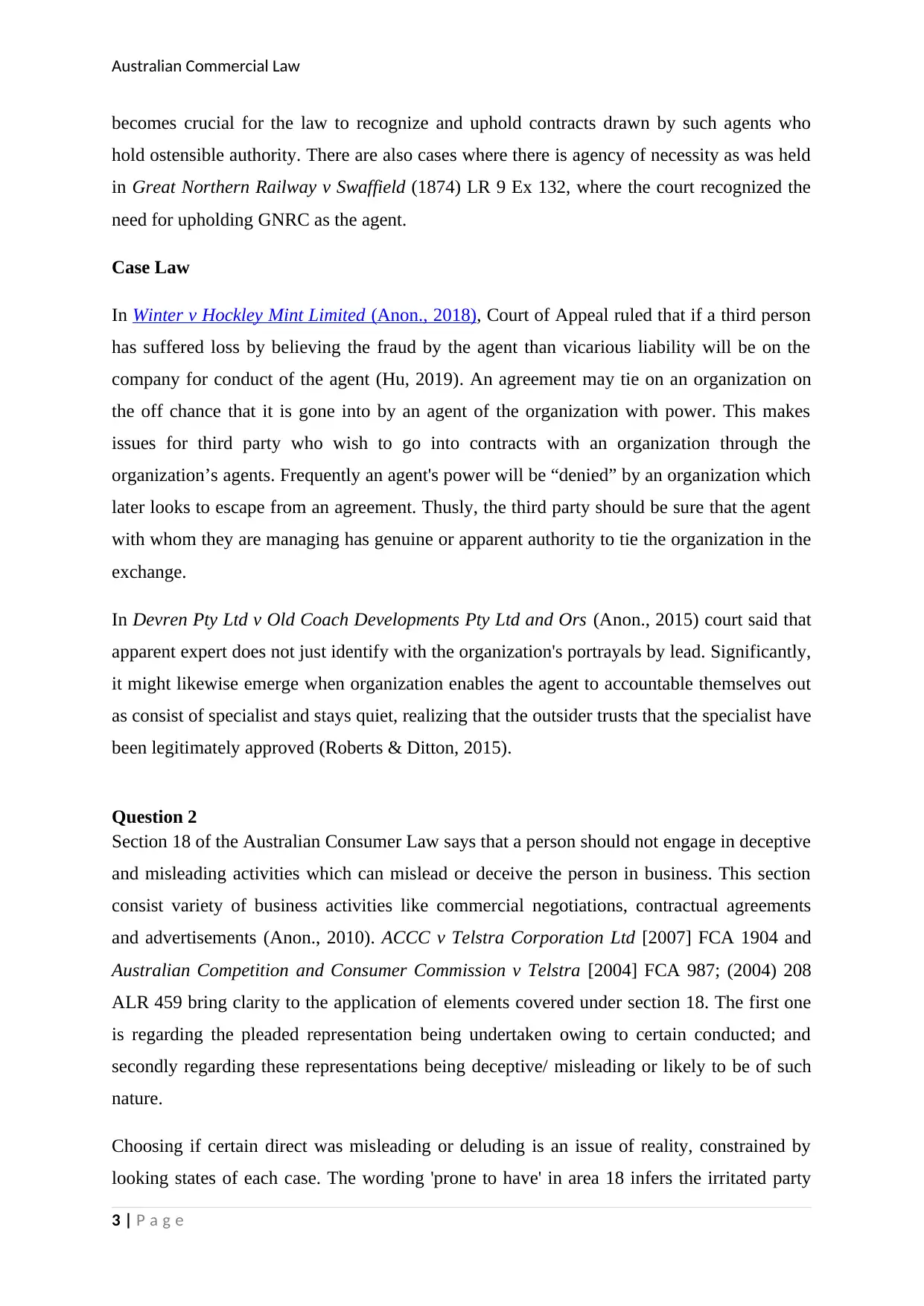
Australian Commercial Law
becomes crucial for the law to recognize and uphold contracts drawn by such agents who
hold ostensible authority. There are also cases where there is agency of necessity as was held
in Great Northern Railway v Swaffield (1874) LR 9 Ex 132, where the court recognized the
need for upholding GNRC as the agent.
Case Law
In Winter v Hockley Mint Limited (Anon., 2018), Court of Appeal ruled that if a third person
has suffered loss by believing the fraud by the agent than vicarious liability will be on the
company for conduct of the agent (Hu, 2019). An agreement may tie on an organization on
the off chance that it is gone into by an agent of the organization with power. This makes
issues for third party who wish to go into contracts with an organization through the
organization’s agents. Frequently an agent's power will be “denied” by an organization which
later looks to escape from an agreement. Thusly, the third party should be sure that the agent
with whom they are managing has genuine or apparent authority to tie the organization in the
exchange.
In Devren Pty Ltd v Old Coach Developments Pty Ltd and Ors (Anon., 2015) court said that
apparent expert does not just identify with the organization's portrayals by lead. Significantly,
it might likewise emerge when organization enables the agent to accountable themselves out
as consist of specialist and stays quiet, realizing that the outsider trusts that the specialist have
been legitimately approved (Roberts & Ditton, 2015).
Question 2
Section 18 of the Australian Consumer Law says that a person should not engage in deceptive
and misleading activities which can mislead or deceive the person in business. This section
consist variety of business activities like commercial negotiations, contractual agreements
and advertisements (Anon., 2010). ACCC v Telstra Corporation Ltd [2007] FCA 1904 and
Australian Competition and Consumer Commission v Telstra [2004] FCA 987; (2004) 208
ALR 459 bring clarity to the application of elements covered under section 18. The first one
is regarding the pleaded representation being undertaken owing to certain conducted; and
secondly regarding these representations being deceptive/ misleading or likely to be of such
nature.
Choosing if certain direct was misleading or deluding is an issue of reality, constrained by
looking states of each case. The wording 'prone to have' in area 18 infers the irritated party
3 | P a g e
becomes crucial for the law to recognize and uphold contracts drawn by such agents who
hold ostensible authority. There are also cases where there is agency of necessity as was held
in Great Northern Railway v Swaffield (1874) LR 9 Ex 132, where the court recognized the
need for upholding GNRC as the agent.
Case Law
In Winter v Hockley Mint Limited (Anon., 2018), Court of Appeal ruled that if a third person
has suffered loss by believing the fraud by the agent than vicarious liability will be on the
company for conduct of the agent (Hu, 2019). An agreement may tie on an organization on
the off chance that it is gone into by an agent of the organization with power. This makes
issues for third party who wish to go into contracts with an organization through the
organization’s agents. Frequently an agent's power will be “denied” by an organization which
later looks to escape from an agreement. Thusly, the third party should be sure that the agent
with whom they are managing has genuine or apparent authority to tie the organization in the
exchange.
In Devren Pty Ltd v Old Coach Developments Pty Ltd and Ors (Anon., 2015) court said that
apparent expert does not just identify with the organization's portrayals by lead. Significantly,
it might likewise emerge when organization enables the agent to accountable themselves out
as consist of specialist and stays quiet, realizing that the outsider trusts that the specialist have
been legitimately approved (Roberts & Ditton, 2015).
Question 2
Section 18 of the Australian Consumer Law says that a person should not engage in deceptive
and misleading activities which can mislead or deceive the person in business. This section
consist variety of business activities like commercial negotiations, contractual agreements
and advertisements (Anon., 2010). ACCC v Telstra Corporation Ltd [2007] FCA 1904 and
Australian Competition and Consumer Commission v Telstra [2004] FCA 987; (2004) 208
ALR 459 bring clarity to the application of elements covered under section 18. The first one
is regarding the pleaded representation being undertaken owing to certain conducted; and
secondly regarding these representations being deceptive/ misleading or likely to be of such
nature.
Choosing if certain direct was misleading or deluding is an issue of reality, constrained by
looking states of each case. The wording 'prone to have' in area 18 infers the irritated party
3 | P a g e
Paraphrase This Document
Need a fresh take? Get an instant paraphrase of this document with our AI Paraphraser
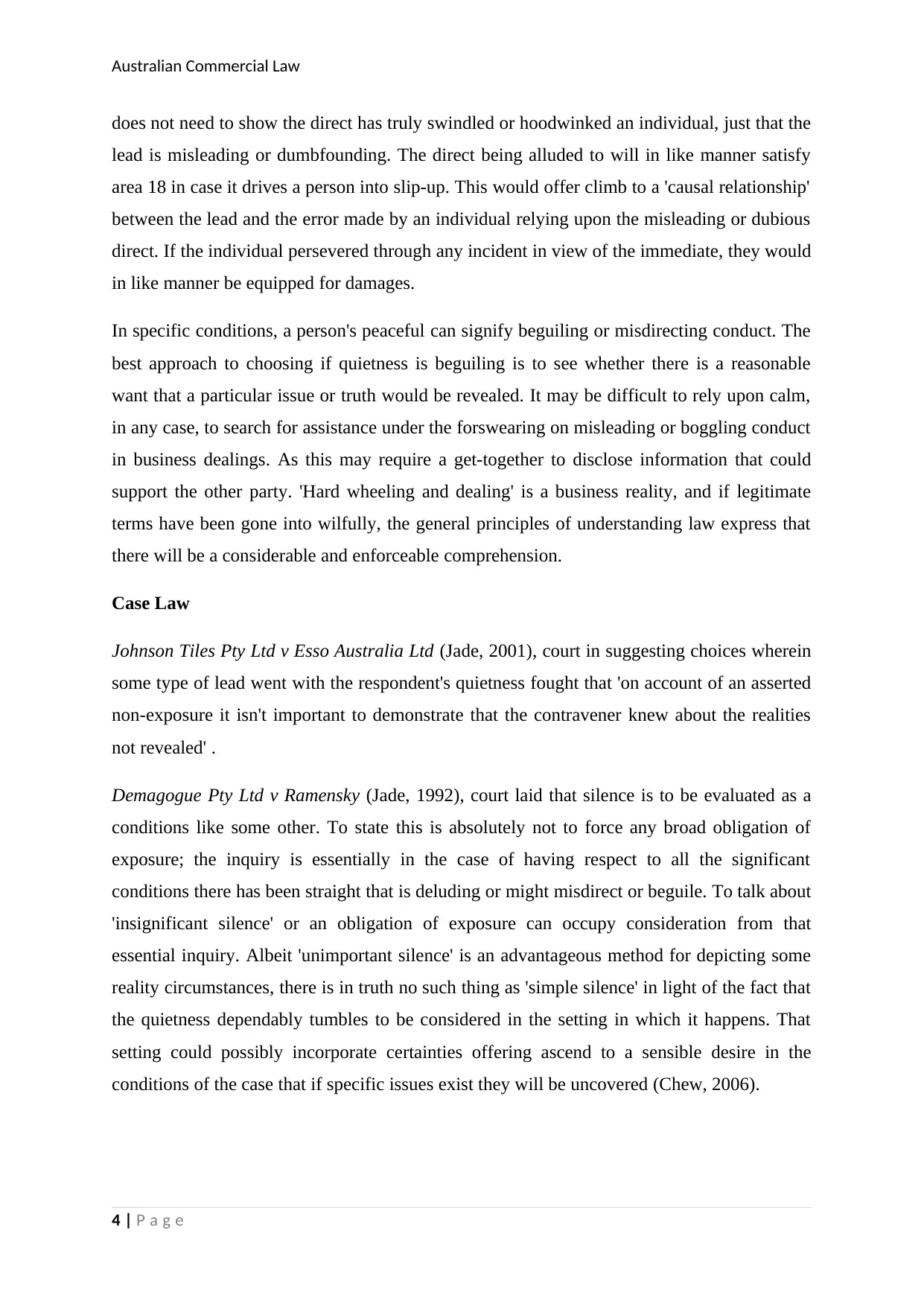
Australian Commercial Law
does not need to show the direct has truly swindled or hoodwinked an individual, just that the
lead is misleading or dumbfounding. The direct being alluded to will in like manner satisfy
area 18 in case it drives a person into slip-up. This would offer climb to a 'causal relationship'
between the lead and the error made by an individual relying upon the misleading or dubious
direct. If the individual persevered through any incident in view of the immediate, they would
in like manner be equipped for damages.
In specific conditions, a person's peaceful can signify beguiling or misdirecting conduct. The
best approach to choosing if quietness is beguiling is to see whether there is a reasonable
want that a particular issue or truth would be revealed. It may be difficult to rely upon calm,
in any case, to search for assistance under the forswearing on misleading or boggling conduct
in business dealings. As this may require a get-together to disclose information that could
support the other party. 'Hard wheeling and dealing' is a business reality, and if legitimate
terms have been gone into wilfully, the general principles of understanding law express that
there will be a considerable and enforceable comprehension.
Case Law
Johnson Tiles Pty Ltd v Esso Australia Ltd (Jade, 2001), court in suggesting choices wherein
some type of lead went with the respondent's quietness fought that 'on account of an asserted
non-exposure it isn't important to demonstrate that the contravener knew about the realities
not revealed' .
Demagogue Pty Ltd v Ramensky (Jade, 1992), court laid that silence is to be evaluated as a
conditions like some other. To state this is absolutely not to force any broad obligation of
exposure; the inquiry is essentially in the case of having respect to all the significant
conditions there has been straight that is deluding or might misdirect or beguile. To talk about
'insignificant silence' or an obligation of exposure can occupy consideration from that
essential inquiry. Albeit 'unimportant silence' is an advantageous method for depicting some
reality circumstances, there is in truth no such thing as 'simple silence' in light of the fact that
the quietness dependably tumbles to be considered in the setting in which it happens. That
setting could possibly incorporate certainties offering ascend to a sensible desire in the
conditions of the case that if specific issues exist they will be uncovered (Chew, 2006).
4 | P a g e
does not need to show the direct has truly swindled or hoodwinked an individual, just that the
lead is misleading or dumbfounding. The direct being alluded to will in like manner satisfy
area 18 in case it drives a person into slip-up. This would offer climb to a 'causal relationship'
between the lead and the error made by an individual relying upon the misleading or dubious
direct. If the individual persevered through any incident in view of the immediate, they would
in like manner be equipped for damages.
In specific conditions, a person's peaceful can signify beguiling or misdirecting conduct. The
best approach to choosing if quietness is beguiling is to see whether there is a reasonable
want that a particular issue or truth would be revealed. It may be difficult to rely upon calm,
in any case, to search for assistance under the forswearing on misleading or boggling conduct
in business dealings. As this may require a get-together to disclose information that could
support the other party. 'Hard wheeling and dealing' is a business reality, and if legitimate
terms have been gone into wilfully, the general principles of understanding law express that
there will be a considerable and enforceable comprehension.
Case Law
Johnson Tiles Pty Ltd v Esso Australia Ltd (Jade, 2001), court in suggesting choices wherein
some type of lead went with the respondent's quietness fought that 'on account of an asserted
non-exposure it isn't important to demonstrate that the contravener knew about the realities
not revealed' .
Demagogue Pty Ltd v Ramensky (Jade, 1992), court laid that silence is to be evaluated as a
conditions like some other. To state this is absolutely not to force any broad obligation of
exposure; the inquiry is essentially in the case of having respect to all the significant
conditions there has been straight that is deluding or might misdirect or beguile. To talk about
'insignificant silence' or an obligation of exposure can occupy consideration from that
essential inquiry. Albeit 'unimportant silence' is an advantageous method for depicting some
reality circumstances, there is in truth no such thing as 'simple silence' in light of the fact that
the quietness dependably tumbles to be considered in the setting in which it happens. That
setting could possibly incorporate certainties offering ascend to a sensible desire in the
conditions of the case that if specific issues exist they will be uncovered (Chew, 2006).
4 | P a g e
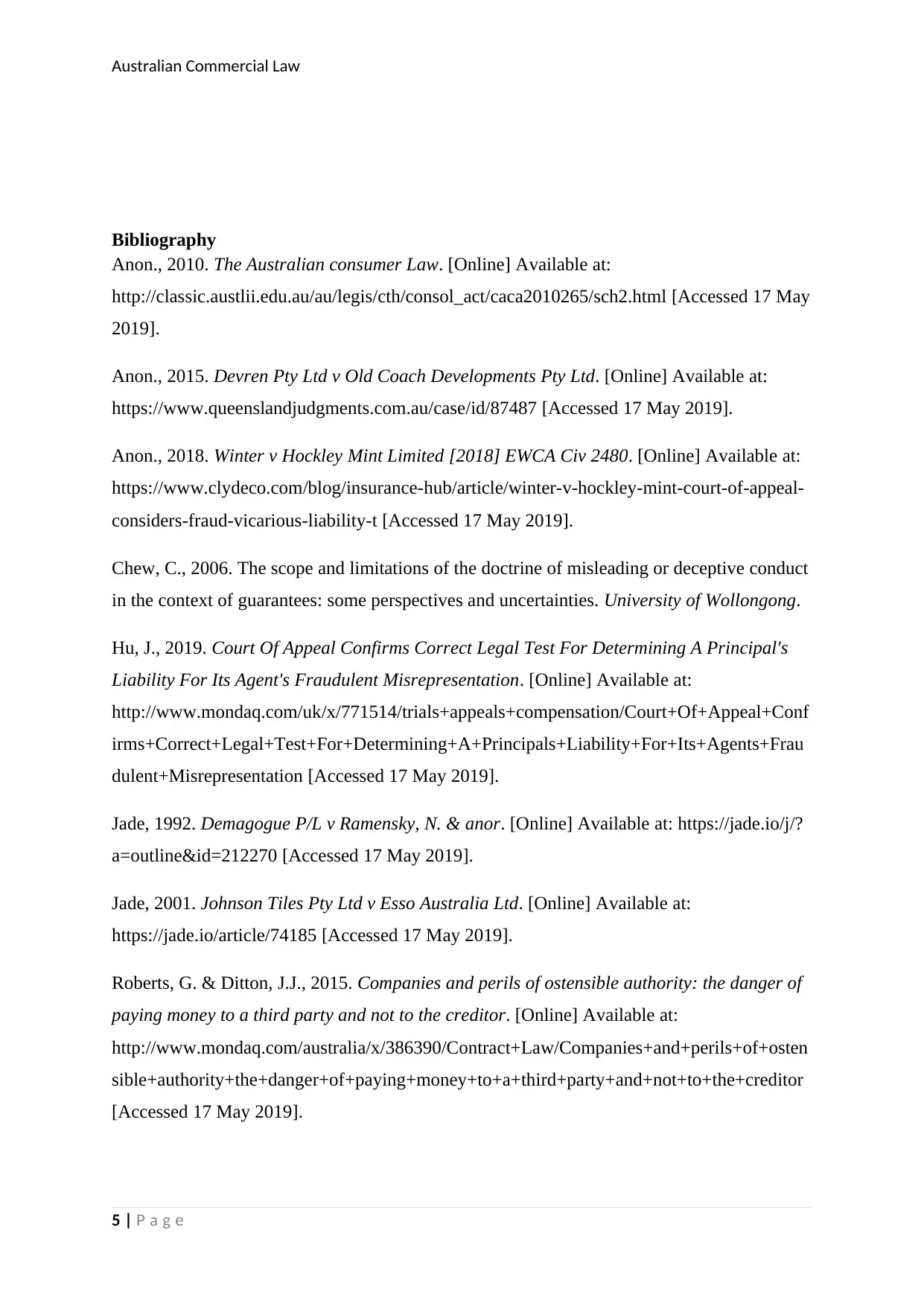
Australian Commercial Law
Bibliography
Anon., 2010. The Australian consumer Law. [Online] Available at:
http://classic.austlii.edu.au/au/legis/cth/consol_act/caca2010265/sch2.html [Accessed 17 May
2019].
Anon., 2015. Devren Pty Ltd v Old Coach Developments Pty Ltd. [Online] Available at:
https://www.queenslandjudgments.com.au/case/id/87487 [Accessed 17 May 2019].
Anon., 2018. Winter v Hockley Mint Limited [2018] EWCA Civ 2480. [Online] Available at:
https://www.clydeco.com/blog/insurance-hub/article/winter-v-hockley-mint-court-of-appeal-
considers-fraud-vicarious-liability-t [Accessed 17 May 2019].
Chew, C., 2006. The scope and limitations of the doctrine of misleading or deceptive conduct
in the context of guarantees: some perspectives and uncertainties. University of Wollongong.
Hu, J., 2019. Court Of Appeal Confirms Correct Legal Test For Determining A Principal's
Liability For Its Agent's Fraudulent Misrepresentation. [Online] Available at:
http://www.mondaq.com/uk/x/771514/trials+appeals+compensation/Court+Of+Appeal+Conf
irms+Correct+Legal+Test+For+Determining+A+Principals+Liability+For+Its+Agents+Frau
dulent+Misrepresentation [Accessed 17 May 2019].
Jade, 1992. Demagogue P/L v Ramensky, N. & anor. [Online] Available at: https://jade.io/j/?
a=outline&id=212270 [Accessed 17 May 2019].
Jade, 2001. Johnson Tiles Pty Ltd v Esso Australia Ltd. [Online] Available at:
https://jade.io/article/74185 [Accessed 17 May 2019].
Roberts, G. & Ditton, J.J., 2015. Companies and perils of ostensible authority: the danger of
paying money to a third party and not to the creditor. [Online] Available at:
http://www.mondaq.com/australia/x/386390/Contract+Law/Companies+and+perils+of+osten
sible+authority+the+danger+of+paying+money+to+a+third+party+and+not+to+the+creditor
[Accessed 17 May 2019].
5 | P a g e
Bibliography
Anon., 2010. The Australian consumer Law. [Online] Available at:
http://classic.austlii.edu.au/au/legis/cth/consol_act/caca2010265/sch2.html [Accessed 17 May
2019].
Anon., 2015. Devren Pty Ltd v Old Coach Developments Pty Ltd. [Online] Available at:
https://www.queenslandjudgments.com.au/case/id/87487 [Accessed 17 May 2019].
Anon., 2018. Winter v Hockley Mint Limited [2018] EWCA Civ 2480. [Online] Available at:
https://www.clydeco.com/blog/insurance-hub/article/winter-v-hockley-mint-court-of-appeal-
considers-fraud-vicarious-liability-t [Accessed 17 May 2019].
Chew, C., 2006. The scope and limitations of the doctrine of misleading or deceptive conduct
in the context of guarantees: some perspectives and uncertainties. University of Wollongong.
Hu, J., 2019. Court Of Appeal Confirms Correct Legal Test For Determining A Principal's
Liability For Its Agent's Fraudulent Misrepresentation. [Online] Available at:
http://www.mondaq.com/uk/x/771514/trials+appeals+compensation/Court+Of+Appeal+Conf
irms+Correct+Legal+Test+For+Determining+A+Principals+Liability+For+Its+Agents+Frau
dulent+Misrepresentation [Accessed 17 May 2019].
Jade, 1992. Demagogue P/L v Ramensky, N. & anor. [Online] Available at: https://jade.io/j/?
a=outline&id=212270 [Accessed 17 May 2019].
Jade, 2001. Johnson Tiles Pty Ltd v Esso Australia Ltd. [Online] Available at:
https://jade.io/article/74185 [Accessed 17 May 2019].
Roberts, G. & Ditton, J.J., 2015. Companies and perils of ostensible authority: the danger of
paying money to a third party and not to the creditor. [Online] Available at:
http://www.mondaq.com/australia/x/386390/Contract+Law/Companies+and+perils+of+osten
sible+authority+the+danger+of+paying+money+to+a+third+party+and+not+to+the+creditor
[Accessed 17 May 2019].
5 | P a g e
⊘ This is a preview!⊘
Do you want full access?
Subscribe today to unlock all pages.

Trusted by 1+ million students worldwide
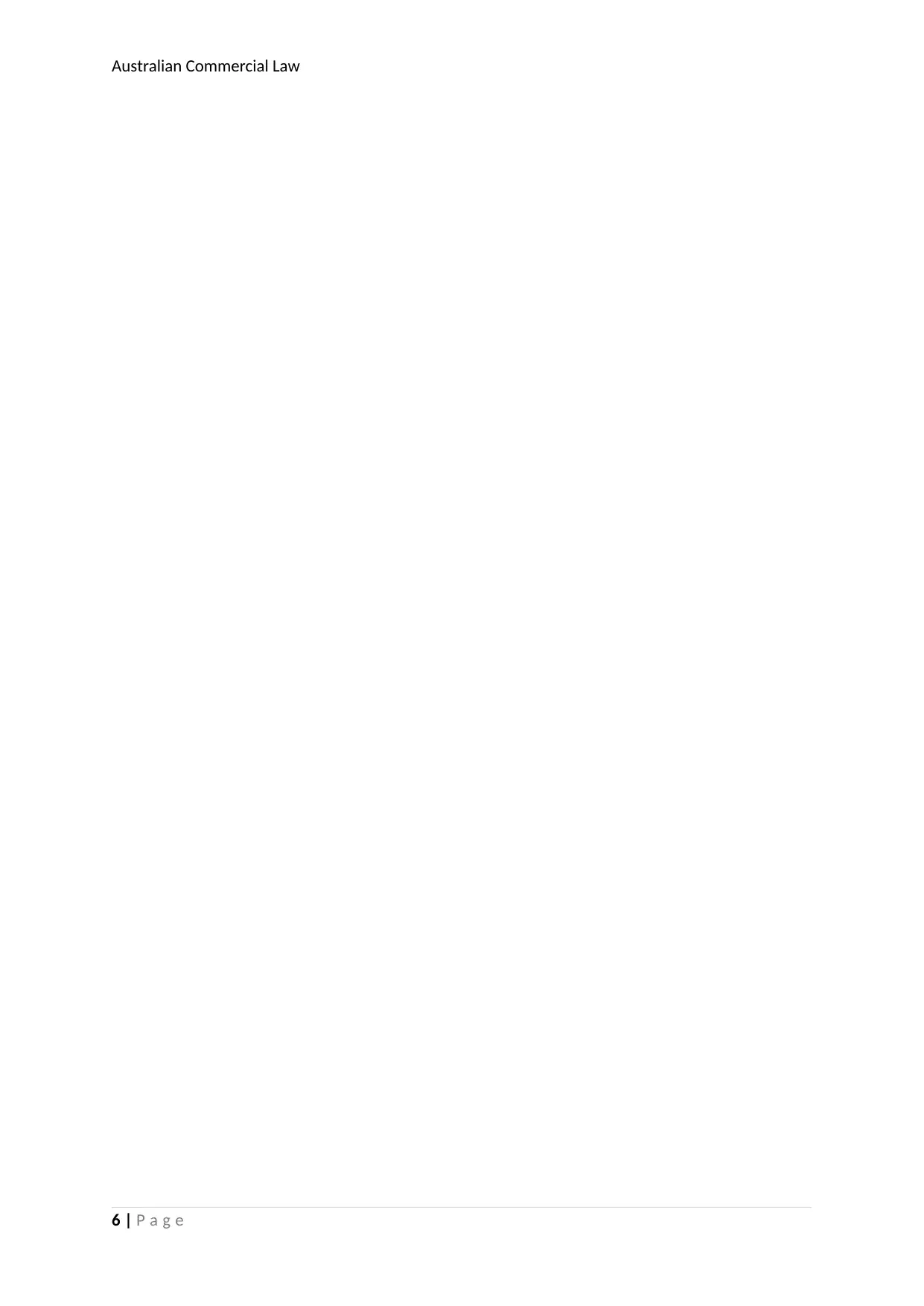
Australian Commercial Law
6 | P a g e
6 | P a g e
1 out of 7
Related Documents
Your All-in-One AI-Powered Toolkit for Academic Success.
+13062052269
info@desklib.com
Available 24*7 on WhatsApp / Email
![[object Object]](/_next/static/media/star-bottom.7253800d.svg)
Unlock your academic potential
Copyright © 2020–2025 A2Z Services. All Rights Reserved. Developed and managed by ZUCOL.





